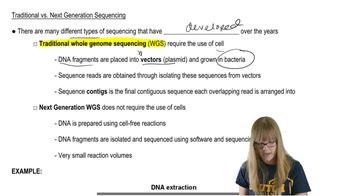What was the significance of the polA1 mutation?
Table of contents
- 1. Introduction to Genetics51m
- 2. Mendel's Laws of Inheritance3h 37m
- 3. Extensions to Mendelian Inheritance2h 41m
- 4. Genetic Mapping and Linkage2h 28m
- 5. Genetics of Bacteria and Viruses1h 21m
- 6. Chromosomal Variation1h 48m
- 7. DNA and Chromosome Structure56m
- 8. DNA Replication1h 10m
- 9. Mitosis and Meiosis1h 34m
- 10. Transcription1h 0m
- 11. Translation58m
- 12. Gene Regulation in Prokaryotes1h 19m
- 13. Gene Regulation in Eukaryotes44m
- 14. Genetic Control of Development44m
- 15. Genomes and Genomics1h 50m
- 16. Transposable Elements47m
- 17. Mutation, Repair, and Recombination1h 6m
- 18. Molecular Genetic Tools19m
- 19. Cancer Genetics29m
- 20. Quantitative Genetics1h 26m
- 21. Population Genetics50m
- 22. Evolutionary Genetics29m
8. DNA Replication
Overview of DNA Replication
Problem 13
Textbook Question
List and describe the function of the ten subunits constituting DNA polymerase III. Distinguish between the holoenzyme and the core enzyme.
 Verified step by step guidance
Verified step by step guidance1
Step 1: Begin by understanding the structure of DNA polymerase III, which is a complex enzyme responsible for DNA replication in prokaryotes. It consists of multiple subunits that work together to ensure high fidelity and efficiency during replication.
Step 2: List the ten subunits of DNA polymerase III holoenzyme: α (alpha), ε (epsilon), θ (theta), β (beta), τ (tau), γ (gamma), δ (delta), δ' (delta prime), χ (chi), and ψ (psi). These subunits are organized into functional groups that contribute to the enzyme's activity.
Step 3: Describe the function of the core enzyme subunits: α (alpha) is responsible for polymerase activity (adding nucleotides), ε (epsilon) provides 3' to 5' exonuclease activity for proofreading, and θ (theta) stabilizes the ε subunit. The core enzyme is essential for the basic replication process.
Step 4: Explain the role of the holoenzyme subunits: The holoenzyme includes the core enzyme plus additional subunits like β (beta), which forms a sliding clamp to increase processivity, and the γ complex (γ, δ, δ', χ, ψ), which acts as a clamp loader to load the β clamp onto DNA. The τ subunit dimerizes the core enzyme, allowing simultaneous replication of both DNA strands.
Step 5: Distinguish between the holoenzyme and the core enzyme: The core enzyme consists of α, ε, and θ subunits and performs the fundamental polymerization and proofreading functions. The holoenzyme includes the core enzyme plus accessory subunits (β, γ complex, τ) that enhance processivity, coordination, and efficiency during replication.
 Verified video answer for a similar problem:
Verified video answer for a similar problem:This video solution was recommended by our tutors as helpful for the problem above
Video duration:
2mPlay a video:
Was this helpful?
Key Concepts
Here are the essential concepts you must grasp in order to answer the question correctly.
DNA Polymerase III Structure
DNA Polymerase III is a multi-subunit enzyme essential for DNA replication in prokaryotes. It consists of ten subunits, including the core enzyme made up of three main subunits (α, ε, and θ) responsible for polymerization and proofreading, and additional subunits that enhance its stability and processivity. Understanding the specific roles of these subunits is crucial for grasping how DNA replication is efficiently carried out.
Recommended video:
Guided course

DNA Structure
Holoenzyme vs. Core Enzyme
The holoenzyme of DNA Polymerase III refers to the complete enzyme complex that includes the core enzyme along with additional subunits, such as the clamp loader and sliding clamp. This configuration allows for high processivity during DNA synthesis. In contrast, the core enzyme alone lacks the necessary components for optimal function, highlighting the importance of the holoenzyme in facilitating effective DNA replication.
Recommended video:
Guided course

Traditional vs. Next-Gen
Function of DNA Polymerase III Subunits
Each of the ten subunits of DNA Polymerase III has a specific function that contributes to the overall activity of the enzyme. For example, the α subunit is responsible for the polymerization of nucleotides, while the ε subunit provides proofreading capabilities to correct errors during DNA synthesis. Understanding these functions is essential for comprehending how DNA Polymerase III maintains fidelity and efficiency in DNA replication.
Recommended video:
Guided course

Functional Genomics
Related Videos
Related Practice
Textbook Question
808
views


